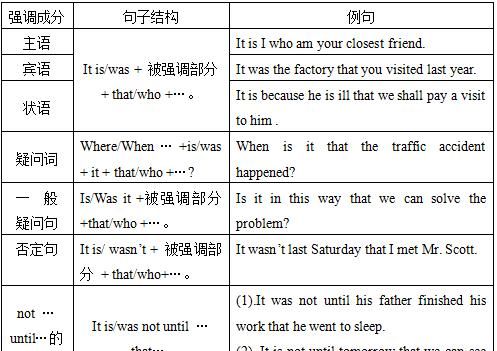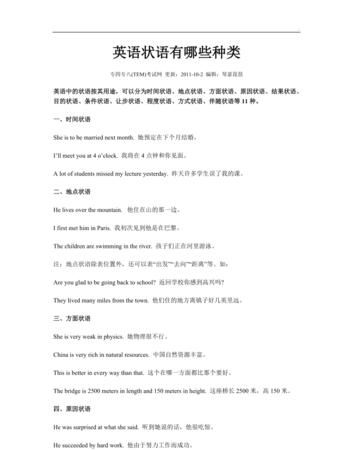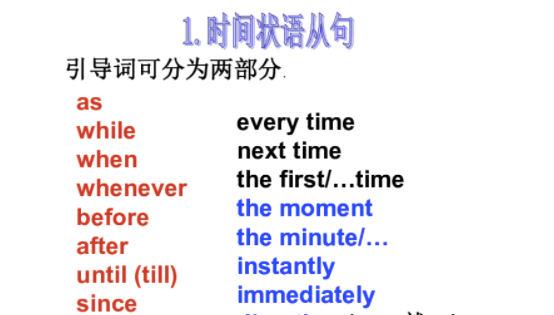本文目录
英语什么是状语有哪些种类的
从功能语法的角度,英语状语的分类:环境状语,情态状语,连接状语,分别体现语言的三大元功能:概念功能,人际功能,语篇功能。下面是我整理的英语什么是状语,欢迎阅读。
英语什么是状语
就是动词的八个状态:时间、地点、原因、状态、目的、结果、方式、程度.
修饰动词、形容词、副词以及全句的句子成份叫状语。例如:
My parents often tell us about their bitter life in the past.我父母经常给我们讲他们过去的苦难生活。
She studies hard.她努力学习。
I am very tired.我非常疲倦。
英语状语有哪些种类
英语中的状语按其用途,可以分为时间状语、地点状语、方面状语、原因状语、结果状语、目的状语、条件状语、让步状语、程度状语、方式状语、伴随状语等11种。
一、时间状语
She is to be married next month. 她预定在下个月结婚。
I’ll meet you at 4 o’clock. 我将在4点钟和你见面。
A lot of students missed my lecture yesterday. 昨天许多学生误了我的课。
二、地点状语
He lives over the mountain. 他住在山的那一边。
I first met him in Paris. 我初次见到他是在巴黎。
The children are swimming in the river. 孩子们正在河里游泳。
注:地点状语除表位置外,还可以表“出发”“去向”“距离”等。
如:Are you glad to be going back to school? 返回学校你感到高兴吗?
They lived many miles from the town. 他们住的地方离镇子好几英里远。
三、方面状语
She is very weak in physics. 她物理很不行。
China is very rich in natural resources. 中国自然资源丰富。
This is better in every way than that. 这个在哪一方面都比那个要好。
The bridge is 2500 meters in length and 150 meters in height. 这座桥长2500米,高150米。
四、原因状语
He was surprised at what she said. 听到她说的话,他很吃惊。
He succeeded by hard work. 他由于努力工作而成功。
He was sent to prison for robbery. 他因为抢劫而坐牢。
Last week she fell ill from cold. 上星期她着凉生病了。
We’re proud of our motherland. 我们为祖国感到骄傲。
五、结果状语
He talked his wife into buying a car. 他说服他妻子买一辆小汽车。
The box is too heavy for me to lift. 这个箱子太重了,我提不动。
It rained heavily, causing severe flooding in that country. 大雨滂沱,造成了那个国家洪水泛滥。
He went to Africa in 1963, never to come back. 他在1963年到非洲,然后就再也没回来过了。
六、目的状语
They went out for a walk. 他们出去散步了。
He saves on behalf of his son. 他为儿子存钱。
He stood aside for her to pass. 他靠边站让她过去。
He cupped his ear to hear better. 他的手捂着耳朵,以便听得更清楚。
He went to the south in search of a better life. 他去南方寻求更好的生活。
I went to France not to study French, but to study architecture. 我去法国不是为了学法语,而是为了学建筑。
七、条件状语
Can you see without your glasses? 你不戴眼镜能看得清东西吗?
United, we stand;divided, we fall. 团结则存,分裂则亡。
With more money I would be able to buy it. 钱多一点的话,我就买得起。
To look at him you could hardly help laughing. 看到他你就会忍不住笑起来。
We must be losing at least a third of our staff under new technology. 在新的技术条件下,我们必定要解雇至少三分之一的员工。
Weather permitting, we’ll have the match tomorrow. 天气允许的话,我们将于明天进行比赛。
八、让步状语
For all his money, he’s a very lonely man. 他虽然富有,可是非常寂寞。
Carol went to work in spite of feeling ill. 卡洛尔尽管感到不舒服仍去上了班。
With all his efforts, he lost the match. 虽然尽了全力,他还是输了那场比赛。
You couldn’t do that to save your life. 你即使为了救自己的命也不能那样做。
Laughed at by everybody, he had my sympathy. 人人都嘲笑他,但我却同情他。
Knowing all this, they made me pay for the damage. 他们尽管了解这一切,还是要我赔偿损失。
九、程度状语
I don’t like coffee very much. 我不太喜欢咖啡。
To a great extent, it is not fair. 在很大程度上,这是不公平的。
The system which is used in this school is very successful. 这个学校所施行的制度是非常成功的。
十、方式状语
We came on the bus. 我们坐公共汽车来的。
You must pay the bill in cash. 你必须用现金付账。
I watched the game on television. 我在电视上收看了那场比赛。
We see with our eyes, and hear with our ears. 我们用眼睛看,用耳朵听。
I heard of the job through a newspaper advertisement. 我从报上的广告中知道了这个工作。
十一、伴随状语
I slept with the window open. 我开着窗睡觉。
She said good-bye with tears in her eyes. 她含着泪水说再见。
He ran up to her breathing heavily. 他气喘吁吁地跑到她跟前。

英语中状语有哪些怎么判断句子
一、什么叫状语?就是动词的八个状态:时间、地点、原因、状态、目的、结果、方式、程度.
修饰动词、形容词、副词以及全句的句子成份叫状语.例如:
My parents often tell us about their bitter life in the past.我父母经常给我们讲他们过去的苦难生活.
She studies hard.她努力学习.
I am very tired.我非常疲倦.
二、什么可以作状语?
1.副词:Say again.再说一遍.
Suddenly it began to rain.天突然下雨了.
2.介词短语:
Please come here in the evening.请晚上来这儿.
He wrote with a red pencil.他用红铅笔写的.
3.动词不定式(或不定式短语):
He went to see a film.他看电影去了.
My father was surprised to hear the news.
我父亲听到这个消息,感到惊奇.
4.分词(或分词短语):
He sat there reading a novel.他坐在那儿看小说.
The students went away laughing.学生们笑着走开了.
5.名词:
Wait a moment.等一会儿.
It can go all day and all night.它能整日整夜地走.
6.状语从句:
I’ll write to you as soon as I get there.
我一到那儿就给你写信.
He didn’t come because he had to stay at home to finish his home work.他没来,因为他不得不留在家里完成家庭作业.
三、状语的分类:
状语按用途可分为:地点、时间、原因、目的、结果、条件、让步、程度、方式、伴随情况等几类.
1.地点状语:
The students are doing their homework in the classroom.学生们正在教室里做作业.
2.时间状语:
I learned a lot from the peasants when I lived in the countryside.我在农村生活时,向农民学到很多东西.
3.目的状语:
They set out early so that they might arrive on time.他们早点动身,以便准时到达.
4.原因状语:
She will not go home because she has to attend a meeting.因为要开会,所以她不能回家了.
5.结果状语:
Li Ming studied so hard that he caught up with the others very quickly.李明学习如此努力,结果很快赶上了其他人.
6.程度状语:
I nearly forgot what he had promised.
我几乎忘记了他答应的事.
7.方式状语:
He came singing and dancing.他唱着跳着走过来.
8.条件状语:
If you work hard at English,you will do well in English.如果你努力学习英语,你的英语成绩就会好.
9.让步状语:
He went to school yesterday though he was ill.
昨天他尽管有病,仍上学去了.
10.比较状语:
Lesson Two is not so difficult as Lesson One.
第二课不像第一课那样难.
四、状语的位置:
一般说来状语在句中的位置比较灵活,它可以处于句首、句中或句末.
1.状语位于句首:为了强调状语或者为了使它与上下文紧密衔接,通常把状语放于句首.
Tomorrow I am going swimming.明天我要去游泳.
Here in the cinema house,smoking is not allowed.
在电影院这里不准吸烟的.
2.状语位于句中:状语在句中的位置是:
(1)如果没有助动词,状语就位于动词前面.
I often go to see a film.我经常看电影.
(2)如果动词前有一个或几个助动词,状语位于第一个助动词之后.
He has already had his lunch.他已吃过午饭了.
(3)如果动词是be,状语就放在be动词之后.
He is always at home.他总是在家.

英语的状语有哪些?(全部)
如下:
for+时间段:常用于现在完成时,如I have learned English for ten years。
since+时间点:常用于现在完成时,如They have lived in Beijing since l995。
lately,recently, just,up to now, till now, so far, these days用于现在完成时的时间状语,常常用来判断句子的时态。
yesterday,last week,at that time,once常用于一般过去时,一般过去时表在过去某个特定时间发生且完成的动作,或过去习惯性动作,不强调对现在的影响,只说明过去。
in +未来时间点:常用于一般将来时,一般将来时表示在将来某个时间会发生的动作或情况。

详细介绍
状语一般由副词、介词短语、分词和分词短语、名词、不定式或相当于副词的词或短语来担当,其位置一般放在句末,但也可放在句首或句中。
副词是一种用来修饰动词,形容词,副词或全句的词,说明时间,地点,程度,方式等概念。
英语中的状语有哪些类型
一、主语:主语表示句子主要说明的人或事物,一般由名词,代词,数词,不定式等充当。
例句:He likes watching TV.他喜欢看电视。
二、谓语:谓语说明主语的动作,状态或特征。
一般可分为两类
1、简单谓语
由动词(或短语动词)构成;可以有不同的时态,语态和语气。
例句:We study for the people.我们为人民学习。
2、复合谓语,情态动词,不定式
例句:I can speak a little English.我可以说一点英语。
三、表语:表语是谓语的一部分,它位于系动词如be之后,说明主语身份,特征,属性或状态。一般由名词,代词,形容词,副词,不定式,介词短语等充当。
例句: My sister is a nurse.我姐姐是护士。
四、宾语:
1、宾语表示动作行为的对象,跟在及物动词之后,能作宾语的有名词,代词,数词,动词不定式等。
例句:We like English.我们喜欢英语。
2、有些及物动词可以带两个宾语,往往一个指人,一个指物,指人的叫间接宾语,指物的叫直接宾语。
例句: He gave me some ink.他给了我一点墨水。
3、有些及物动词的宾语后面还需要有一个补足语,意思才完整,宾语和它的补足语构成复合宾语。
例句:We make him our monitor.我们选他当班长。
五、宾补:就是宾语补足语,就是补充说明宾语的
例句:I know you are student good at maths 在这个句子中good at maths 就是补语。
1、宾语补语也可以是句子,所以这个句子也可以是 I know you are student who is good at maths
2、还可以是-ing 形式I see you crossing the street
简单说就是补充和说明主语和宾语的成分.因此,就出现了主语补足语和宾语补足
语.
六、定语:在句中修饰名词或代词的成分叫定语。
1、用作定语的主要是形容词,代词,数词,名词,副词,动词不定式,介词短语等。形容词,代词,数词,名词等作定语时,通常放在被修饰的词前面。
例句:He is a new student.他是个新生。
2、但副词,动词不定式,介词短语等作定语时,则放在被修饰的词之后。
例句:The bike in the room is mine.房间里的自行车是我的。
七、状语:修饰动词,形容词,副词以及全句的句子成分,叫做状语。用作状语的通常是副词,介词短语,不定式和从句等。状语一般放在被修饰的词之后或放在句尾。副词作状语时可放在被修饰的词前或句首。
例句:He lives in London.他住在伦敦。

以上就是关于英语状语分为哪几种,英语什么是状语有哪些种类的的全部内容,以及英语状语分为哪几种 的相关内容,希望能够帮到您。

